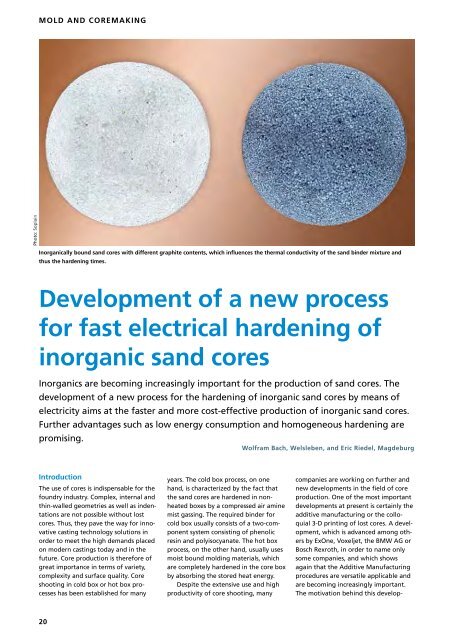CPT International 01/2019
You also want an ePaper? Increase the reach of your titles
YUMPU automatically turns print PDFs into web optimized ePapers that Google loves.
MOLD AND COREMAKING<br />
Photo: Soplain<br />
Inorganically bound sand cores with different graphite contents, which influences the thermal conductivity of the sand binder mixture and<br />
thus the hardening times.<br />
Development of a new process<br />
for fast electrical hardening of<br />
inorganic sand cores<br />
Inorganics are becoming increasingly important for the production of sand cores. The<br />
development of a new process for the hardening of inorganic sand cores by means of<br />
electricity aims at the faster and more cost-effective production of inorganic sand cores.<br />
Further advantages such as low energy consumption and homogeneous hardening are<br />
promising.<br />
Wolfram Bach, Welsleben, and Eric Riedel, Magdeburg<br />
Introduction<br />
The use of cores is indispensable for the<br />
foundry industry. Complex, internal and<br />
thin-walled geometries as well as indentations<br />
are not possible without lost<br />
cores. Thus, they pave the way for innovative<br />
casting technology solutions in<br />
order to meet the high demands placed<br />
on modern castings today and in the<br />
future. Core production is therefore of<br />
great importance in terms of variety,<br />
complexity and surface quality. Core<br />
shooting in cold box or hot box processes<br />
has been established for many<br />
years. The cold box process, on one<br />
hand, is characterized by the fact that<br />
the sand cores are hardened in nonheated<br />
boxes by a compressed air amine<br />
mist gassing. The required binder for<br />
cold box usually consists of a two-component<br />
system consisting of phenolic<br />
resin and polyisocyanate. The hot box<br />
process, on the other hand, usually uses<br />
moist bound molding materials, which<br />
are completely hardened in the core box<br />
by absorbing the stored heat energy.<br />
Despite the extensive use and high<br />
productivity of core shooting, many<br />
companies are working on further and<br />
new developments in the field of core<br />
production. One of the most important<br />
developments at present is certainly the<br />
additive manufacturing or the colloquial<br />
3-D printing of lost cores. A development,<br />
which is advanced among others<br />
by ExOne, Voxeljet, the BMW AG or<br />
Bosch Rexroth, in order to name only<br />
some companies, and which shows<br />
again that the Additive Manufacturing<br />
procedures are versatile applicable and<br />
are becoming increasingly important.<br />
The motivation behind this develop-<br />
20

















